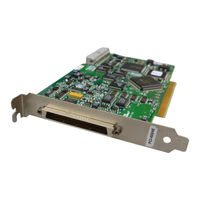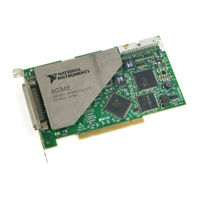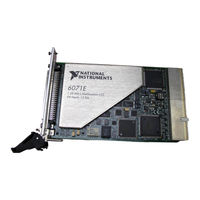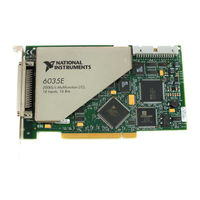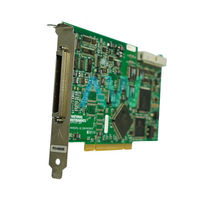User Manuals: National Instruments E Series DAQ
Manuals and User Guides for National Instruments E Series DAQ. We have 7 National Instruments E Series DAQ manuals available for free PDF download: User Manual, Programmer's Manual
National Instruments E Series User Manual (265 pages)
Brand: National Instruments
|
Category: Computer Hardware
|
Size: 3 MB
Table of Contents
-
Conventions13
-
Labview15
-
DAQ Hardware20
-
Daq-Stc21
-
Scxi23
-
Scc24
-
5B Series24
-
Analog Input35
-
Mux35
-
Ai Fifo36
-
Dither42
-
Example 146
-
Example 247
-
NI-Daqmx63
-
Dacs82
-
Dac Fifo82
-
Buffered85
-
Non-Buffered86
Advertisement
National Instruments E Series User Manual (265 pages)
Brand: National Instruments
|
Category: Computer Hardware
|
Size: 3 MB
Table of Contents
-
Conventions13
-
Labview15
-
DAQ Hardware20
-
Daq-Stc21
-
Scxi23
-
Scc24
-
5B Series24
-
Analog Input35
-
Mux35
-
Ai Fifo36
-
Dither42
-
Example 146
-
Example 247
-
NI-Daqmx63
-
Dacs82
-
Dac Fifo82
-
Buffered85
-
Non-Buffered86
National Instruments E Series User Manual (265 pages)
Brand: National Instruments
|
Category: I/O Systems
|
Size: 3 MB
Table of Contents
-
Conventions13
-
Labview15
-
DAQ Hardware20
-
Daq-Stc21
-
Scxi23
-
Scc24
-
5B Series24
-
Analog Input35
-
Mux35
-
Ai Fifo36
-
Dither42
-
Example 146
-
Example 247
-
NI-Daqmx63
-
Dacs82
-
Dac Fifo82
-
Buffered85
-
Non-Buffered86
Advertisement
National Instruments E Series User Manual (265 pages)
Brand: National Instruments
|
Category: I/O Systems
|
Size: 3 MB
Table of Contents
-
Conventions13
-
Labview15
-
DAQ Hardware20
-
Daq-Stc21
-
Scxi23
-
Scc24
-
5B Series24
-
Analog Input35
-
Mux35
-
Ai Fifo36
-
Dither42
-
Example 146
-
Example 247
-
NI-Daqmx63
-
Dacs82
-
Dac Fifo82
-
Buffered85
-
Non-Buffered86
National Instruments E Series User Manual (265 pages)
DAQ
Brand: National Instruments
|
Category: Computer Hardware
|
Size: 3 MB
Table of Contents
-
Conventions13
-
Labview15
-
DAQ Hardware20
-
Daq-Stc21
-
Scxi23
-
Scc24
-
5B Series24
-
Analog Input35
-
Mux35
-
Ai Fifo36
-
Dither42
-
Example 146
-
Example 247
-
NI-Daqmx63
-
Dacs82
-
Dac Fifo82
-
Buffered85
-
Non-Buffered86
National Instruments E Series Programmer's Manual (162 pages)
Register-Level Programmer Manual, Multifunction I/O Boards for PCI Bus Computers, Register-Level
Brand: National Instruments
|
Category: I/O Systems
|
Size: 1 MB
Table of Contents
-
-
-
-
Register Map40
-
-
National Instruments E Series User Manual (132 pages)
Multifunction I/O Cards for PCMCIA
Brand: National Instruments
|
Category: I/O Systems
|
Size: 0 MB
Table of Contents
-
-
Unpacking19
-
-
Analog Input24
-
Input Mode24
-
Dither28
-
-
Digital I/O34
-
-
-
-
-
TRIG1 Signal63
-
TRIG2 Signal65
Advertisement
Related Products
- National Instruments Ettus USRP E310
- National Instruments ENET-232 Series
- National Instruments ENET-485 Series
- National Instruments NI ENET-9000 Series
- National Instruments NI EDIDS-2400 Series
- National Instruments NI EDIDS-2403
- National Instruments NI EDIDS-2406
- National Instruments EMSA-9068
- National Instruments NI EDIDS-2412
- National Instruments NI EDIDS-2409
